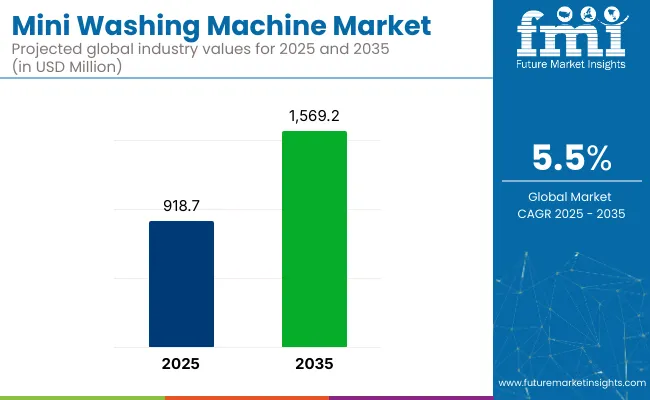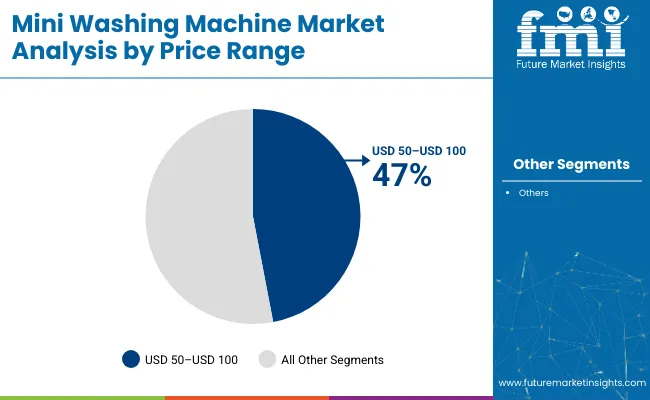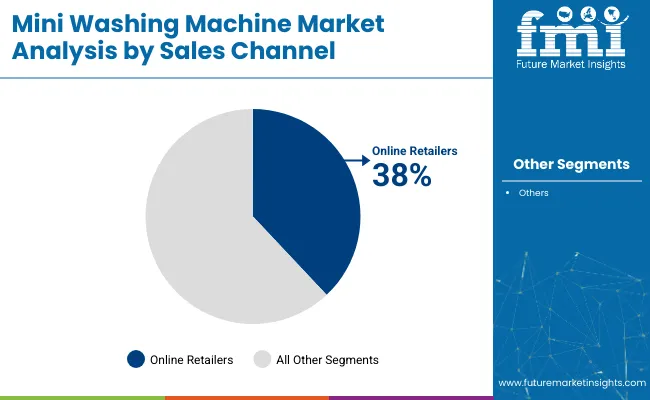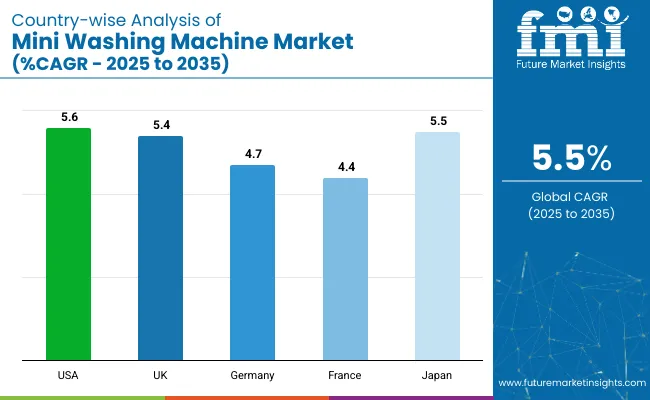The global mini washing machine market is valued at USD 918.7 million in 2025 and is slated to reach USD 1,569.2 million by 2035, reflecting a CAGR of 5.5%. Growth in the market has been attributed to multiple interlinked factors that reflect shifting lifestyle trends and regulatory influence.

| Metric | Value |
|---|---|
| Market Size (2025) | USD 918.7 million |
| Market Size (2035) | USD 1,569.2 million |
| CAGR (2025 to 2035) | 5.5% |
Rapid urbanization and the rise of compact living spaces have significantly increased the demand for space-saving household appliances. Consumers are placing greater emphasis on energy efficiency and sustainability, prompting a shift toward mini washers that use less water and electricity. Additionally, the expansion of e-commerce platforms has made these products more accessible, especially in emerging markets.
Recent innovation in this market has been driven by advancements in smart technology, energy efficiency, and compact design. AI-enabled wash programs, inverter motors, and IoT connectivity have been integrated to enhance performance and user convenience.
Manufacturers like LG and Panasonic have introduced heat-pump technology and smart controls for optimized water and energy use. Additionally, ventless and foldable models have been launched to cater to space-constrained consumers. Eco-friendly materials and low-noise designs have also been prioritized. These innovations have been aimed at meeting the growing demand for sustainable, user-friendly, and high-performing appliances in urban and mobile living environments.
Government regulations have played a crucial role in shaping the mini washing machine market, particularly in the areas of energy efficiency, water conservation, and environmental compliance. Regulatory bodies such as the USA Department of Energy (DOE), Energy Star Program, and the European Commission have enforced stringent standards requiring manufacturers to meet minimum efficiency and performance thresholds. In Europe, the Ecodesign Directive and mandatory energy labeling have guided the development of low-energy, recyclable models.
The USA is projected to be the fastest-growing market for mini washing machines, with a CAGR of 5.6%. The residential segment will lead the end-user category with 64% market share by 2025. The USD 50-USD 100 price range will dominate with a 47% share. North America is anticipated to be the key growth region. Japan and the UK are also expected to see strong growth, with CAGRs of 5.5% and 5.4%, respectively.
The mini washing machine market has been categorized by end users into residential and commercial. By price, the market includes range under USD 50, USD 50-USD 100, above USD 100. By sales channels, the market is divided into supermarket/hypermarket, specialty stores, wholesalers/distributors, online retailers, and convenient stores. Regionally, the market is analyzed across North America, Latin America, Western Europe, Eastern Europe, East Asia, South Asia Pacific, and Middle East and Africa.
The residential segment has been identified as the lucrative end-user category with a 64% share in 2025. This segment is poised to capture the larger revenue share and demonstrate faster value expansion than the commercial segment.

The USD 50-USD 100 price range segment has been projected to command the largest share of the mini washing machine market in 2025, accounting for approximately 47% of global revenue. Its dominance has been attributed to the ideal balance it offers between affordability, performance, and durability.

The online retailers segment has been projected to dominate the mini washing machine market, capturing an estimated 38% market share in 2025. This leadership is due to the rise of e-commerce, changes in consumer shopping habits towards online platforms, and more compact appliances being available through direct sales and third-party sellers.

The mini washing machine market is experiencing steady growth, fueled by increasing urbanization, rising demand for space-saving appliances, and growing consumer preference for energy-efficient and portable laundry solutions.
Recent Trends in the Mini Washing Machine Market
Challenges in the Mini Washing Machine Market

The global mini washing machine market is witnessing rapid growth, driven by the increasing demand for compact and energy-efficient appliances, urbanization, and the rise of single-person households. With the growing need for space-saving solutions and environmentally conscious consumer behavior, mini washing machines are becoming increasingly popular in both developed and emerging markets.
The USA mini washing machines market is projected to grow at a CAGR of 5.6% during the 2025 to 2035 forecast period. Growth has been attributed to rising demand for space-saving appliances in urban apartments and student housing, along with growing consumer preference for energy-efficient models that meet federal Energy Star standards.
The UK mini washing machines market is projected to expand at a CAGR of 5.4% from 2025 to 2035. The segment has been supported by strong demand for compact and portable washers in studio flats and shared accommodations, as well as growing interest in sustainable laundry solutions among urban households.
Germany’s mini washing machines market is expected to experience at a CAGR of 4.7% from 2025 to 2035. The rise has been attributed to strong environmental regulations, high awareness of energy efficiency, and the increasing number of single-person households in metropolitan areas.
The French mini washing machine market is predicted to expand at a CAGR of 4.4% during the forecast period. Urban consumers seeking convenience and small-scale laundry solutions have been key growth contributors, with a visible shift toward online channels and eco-labeled machines.
Japan’s mini washing machines market is poised to expand at a CAGR of 5.5% from 2025 to 2035, supported by a high concentration of small households, advanced technology adoption, and a cultural emphasis on cleanliness and appliance longevity.
The mini washing machine market has been identified as relatively fragmented, with no single supplier monopolizing the space; however, consolidation is being observed among leading appliance manufacturers. Prominent companies such as LG, Haier (including its subsidiary Candy), Whirlpool, Panasonic, and Midea have been recognized as key global suppliers, leveraging strategies involving competitive pricing, product innovation, strategic partnerships, and expansion into emerging regions.
Top companies have been seen to compete through innovation, introducing energy-efficient, smart-featured models, while pricing strategies have been tailored to various income segments via under-USD 50 to premium-priced machines. Expansion into e-commerce and urbanizing regions has been pursued through collaborations with online retailers and local distributors, whereas regional manufacturing hubs in East Asia, Europe, and North America have been established to better serve their markets.
Recent Mini Washing Machine Industry News
| Report Attributes | Details |
|---|---|
| Market Size (2025) | USD 918.7 million |
| Projected Market Size (2035) | USD 1,569.2 million |
| CAGR (2025 to 2035) | 5.5% |
| Base Year for Estimation | 2024 |
| Historical Period | 2020 to 2024 |
| Projections Period | 2025 to 2035 |
| Report Parameters | Revenue in USD millions/Volume in units |
| End User Analyzed | Residential and Commercial |
| Price Range Analyzed | Under USD 50, USD 50-USD 100, and Above USD 100 |
| Sales Channel Analyzed | Supermarket/Hypermarket, Specialty Stores, Wholesalers/Distributors, Online Retailers, and Convenience Stores |
| Regions Covered | North America, Latin America, Western Europe, Eastern Europe, East Asia, South Asia Pacific, and Middle East & Africa |
| Countries Covered | United States, Canada, Brazil, Germany, United Kingdom, France, Japan, China, India, South Korea, Australia |
| Key Players | Whirlpool Corporation; LG Electronics; Panasonic Corporation; Qingdao Haier Co., Ltd.; Robert Bosch GmbH; Electrolux AG; General Electric Co.; Toshiba, Funai Corporation, Inc. (Sanyo); Royalstar |
| Additional Attributes | Dollar sales by value, market share analysis by region, country-wise analysis. |
The mini washing machine market is valued at USD 918.7 million in 2025.
The market is forecasted to reach USD 1,569.2 million, reflecting a CAGR of 5.5%.
The residential segment will lead the market by end user with a 64% market share in 2025.
The USD 50-USD 100 segment will lead the market with a 47% share in 2025.
The USA is projected to witness the fastest growth, with a 5.6% CAGR from 2025 to 2035.






Our Research Products

The "Full Research Suite" delivers actionable market intel, deep dives on markets or technologies, so clients act faster, cut risk, and unlock growth.

The Leaderboard benchmarks and ranks top vendors, classifying them as Established Leaders, Leading Challengers, or Disruptors & Challengers.

Locates where complements amplify value and substitutes erode it, forecasting net impact by horizon

We deliver granular, decision-grade intel: market sizing, 5-year forecasts, pricing, adoption, usage, revenue, and operational KPIs—plus competitor tracking, regulation, and value chains—across 60 countries broadly.

Spot the shifts before they hit your P&L. We track inflection points, adoption curves, pricing moves, and ecosystem plays to show where demand is heading, why it is changing, and what to do next across high-growth markets and disruptive tech

Real-time reads of user behavior. We track shifting priorities, perceptions of today’s and next-gen services, and provider experience, then pace how fast tech moves from trial to adoption, blending buyer, consumer, and channel inputs with social signals (#WhySwitch, #UX).

Partner with our analyst team to build a custom report designed around your business priorities. From analysing market trends to assessing competitors or crafting bespoke datasets, we tailor insights to your needs.
Supplier Intelligence
Discovery & Profiling
Capacity & Footprint
Performance & Risk
Compliance & Governance
Commercial Readiness
Who Supplies Whom
Scorecards & Shortlists
Playbooks & Docs
Category Intelligence
Definition & Scope
Demand & Use Cases
Cost Drivers
Market Structure
Supply Chain Map
Trade & Policy
Operating Norms
Deliverables
Buyer Intelligence
Account Basics
Spend & Scope
Procurement Model
Vendor Requirements
Terms & Policies
Entry Strategy
Pain Points & Triggers
Outputs
Pricing Analysis
Benchmarks
Trends
Should-Cost
Indexation
Landed Cost
Commercial Terms
Deliverables
Brand Analysis
Positioning & Value Prop
Share & Presence
Customer Evidence
Go-to-Market
Digital & Reputation
Compliance & Trust
KPIs & Gaps
Outputs
Full Research Suite comprises of:
Market outlook & trends analysis
Interviews & case studies
Strategic recommendations
Vendor profiles & capabilities analysis
5-year forecasts
8 regions and 60+ country-level data splits
Market segment data splits
12 months of continuous data updates
DELIVERED AS:
PDF EXCEL ONLINE
Washing Machine Cleaner Market Analysis - Trends, Growth & Forecast 2025 to 2035
Washing Machine Market Analysis by Various Materials, Thickness Capacity Type Through 2035
Mini Track Machinery Market Size and Share Forecast Outlook 2025 to 2035
Miniplate for Bone Fixation Market Size and Share Forecast Outlook 2025 to 2035
Miniature Electrochemical CO Sensor Market Size and Share Forecast Outlook 2025 to 2035
Mini LED Solder Pastes and Fluxes Market Size and Share Forecast Outlook 2025 to 2035
Miniature Duplex Connectors Market Size and Share Forecast Outlook 2025 to 2035
Mining Lubricant Market Size and Share Forecast Outlook 2025 to 2035
Machine Glazed Paper Market Size and Share Forecast Outlook 2025 to 2035
Machine Glazed Kraft Paper Market Forecast and Outlook 2025 to 2035
Machine Condition Monitoring Market Size and Share Forecast Outlook 2025 to 2035
Machine Glazed Paper Industry Analysis in Asia Pacific Forecast Outlook 2025 to 2035
Mining Remanufacturing Component Market Forecast Outlook 2025 to 2035
Mining Hose Market Size and Share Forecast Outlook 2025 to 2035
Mining Equipment Industry Analysis in Latin America Size and Share Forecast Outlook 2025 to 2035
Mining Tester Market Size and Share Forecast Outlook 2025 to 2035
Machine Vision Camera Market Size and Share Forecast Outlook 2025 to 2035
Mini Cranes Market Size and Share Forecast Outlook 2025 to 2035
Mining Pneumatic Saw Market Size and Share Forecast Outlook 2025 to 2035
Mini Grid Market Size and Share Forecast Outlook 2025 to 2035

Thank you!
You will receive an email from our Business Development Manager. Please be sure to check your SPAM/JUNK folder too.
Chat With
MaRIA